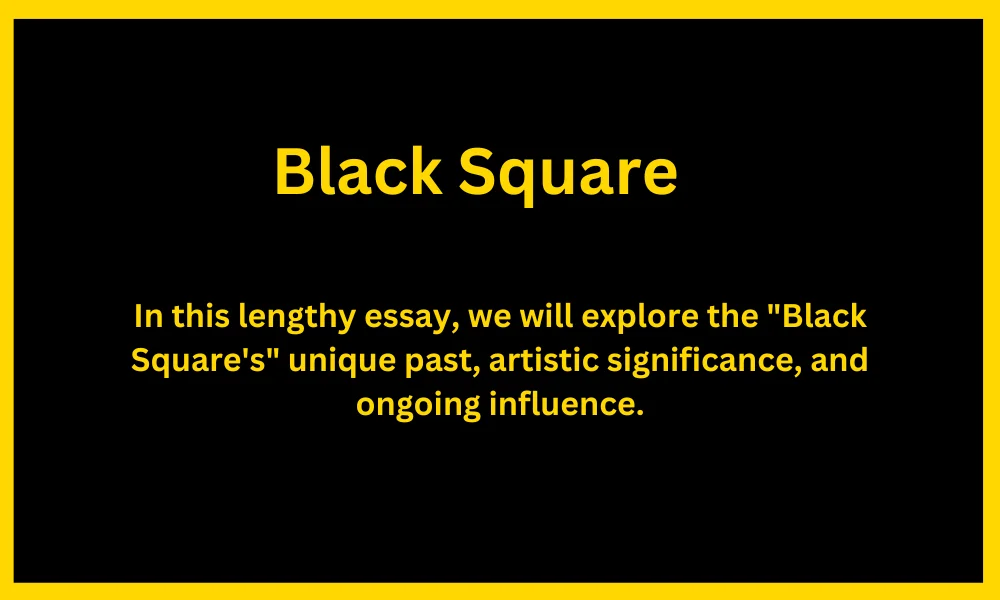Black Square
“Black Square”: A Detailed Exploration
“Black Square” is a representation of minimalism, debate, and creative experimentation in the world of art. Kazimir Malevich, a Russian artist, produced this famous masterpiece in 1915, and it still inspires debate and thought among art lovers, academics, and the general public.

We will delve into the “Black Square’s” fascinating past, artistic significance, and continuing influence in this extensive piece.
Introduction
The “Black Square” is a powerful statement that questions the whole nature of art itself, not just a canvas that has been painted wholly black.
We will explore the mysterious world of the “Black Square,” learning about its history, the debate it sparked, its ongoing impact, and its role in the modern art world as we go.
There is only one piece of artwork that defies convention and encourages reflection in the world of art, where colour, form, and imagination interact to elicit feelings and thoughts: the “Black Square.
” This enigmatic masterpiece, created by the brilliant Russian artist Kazimir Malevich in 1915, has transcended its canvas to stand for artistic minimalism, debate, and creative innovation.
The “Black Square” confounds the entire foundation of what art stands for, leaving viewers perplexed, angry, and interested. There is a profound statement about the development of artistic expression and the boundless potential of human ingenuity behind its cold, black surface.
As we begin our investigation of the “Black Square,” we will learn more about its interesting history, the controversy it sparked, its ongoing impact on art, and its position in the dynamic environment of modern innovation.
Discover the depths of meaning, controversy, and creative significance that have shaped the “Black Square” into an enduring landmark in the field of art as we journey across time and aesthetics.
The Birth of the “Black Square”
Early Life of Kazimir Malevich
To comprehend the origins of the “Black Square,” we must first become familiar with Kazimir Malevich’s life and ideology. Malevich, who was born in Ukraine in 1879, helped to form the Russian avant-garde movement.
His artistic development was characterized by a constant search for abstraction and a desire to defy accepted artistic rules.
Knowing Kazimir Malevich, the artist who created the “Black Square,” and his life’s work is essential to understanding how it came to be. Malevich, who was born in Ukraine in 1879, was destined to pave the way for the Russian avant-garde art movement.
His artistic journey was defined by an unyielding dedication to abstraction and an unquenchable ambition to challenge accepted artistic norms.
The Emergence of Suprematism
Malevich played a significant role in the formation of Suprematism at the beginning of the 20th century, an artistic style that aimed to express the “supremacy of pure feeling” using abstract and geometric shapes. This environment gave rise to the “Black Square” upon its birth.
Kazimir Malevich became a key figure in the Suprematism art style, which sought to capture the “supremacy of pure feeling” through abstract and geometric forms, at the beginning of the 20th century.
The “Black Square” was created inside this avant-garde environment.
We will examine the ideas, inspirations, and creative theories that drove Malevich to produce a work that would challenge the very notion of what is considered to be art as we go deeper into the creation of this renowned piece.
The Making of the Masterpiece
Materials and Techniques
Malevich’s “Black Square” was a skillfully constructed work of art, not just a haphazard application of black paint. On a white canvas, he used oil paint, producing a sharp contrast that highlighted the black square’s presence.
The message was sophisticated, but the materials were simple.
Malevich’s “Black Square” was not made by randomly painting a black square on a canvas. It was a well produced piece of art that called for careful consideration of the tools and materials used.
Malevich purposefully created a strong contrast by using oil paint on a white canvas to highlight the presence of the black square. The message’s complexity was concealed by the materials’ apparent simplicity.
Symbolism and Meaning
Despite appearing to have no meaning, the black square represented a fundamental break from representational painting. Malevich thought it represented a departure from the past and a step into the unknown, as well as the “zero degree” of painting.
It was like staring at an empty canvas.
The “Black Square” could initially appear to have no apparent significance, just a black geometric design on a white background.
This composition’s seeming simplicity, nonetheless, belied a powerful message. Malevich said that the black square represented painting’s “zero degree”—a break from the past and a step towards the unknown.

It was a piece of art that went beyond the requirement for depiction and prompted spectators to consider what art is really all about.
We will reveal the depths of symbolism and significance hidden within Malevich’s “Black Square,” illuminating why this ostensibly somber masterwork continues to capture the attention of the art world and the public imagination.
The Controversy Surrounding “Black Square”
Initial Reactions
The “Black Square” was first displayed by Malevich in 1915, to much confusion and fury. An empty, black vacuum on the wall presented to exhibition attendees challenged their preconceived ideas of what constitutes art. Some brushed it off as a simple joke.
The “Black Square” sparked a variety of responses when Kazimir Malevich originally showed it in 1915, from amazement to indignation. An empty, black space on the wall greeted visitors to the show, a sharp contrast to the traditional art they were used to.
This unconventional piece of music questioned many people’s ideas about what art should be. Some, unable to comprehend its meaning, rejected it as a simple joke or practical joke.
Censorship and Suppression
The “Black Square” was subjected to restriction and suppression by authorities who saw it as subversive as the avant-garde movement gained pace. But Malevich remained steadfast in his devotion to Suprematism.
The “Black Square” evolved into a hotbed of debate and unrest as the avant-garde movement gained traction. Authorities tried to stifle its message because they saw it as subversive.
Malevich, however, remained unwavering in his devotion to Suprematism and the creative revolution it stood for. The “Black Square”‘s battle for recognition was not only artistic but also political and cultural, reflecting the turbulent time in which it first appeared.
This part will go into greater detail on the responses to Malevich’s masterwork and the difficulties it encountered in a setting hostile to such extreme artistic expression.
Evolution and Influence
Legacy in Modern Art
Despite some initial backlash, the “Black Square” has irrevocably changed modern art. Generations of artists have been influenced by it to investigate minimalism, abstraction, and the limits of artistic expression.
Despite the “Black Square” by Kazimir Malevich’s initial criticism and the unorthodox nature of its production, it has irrevocably changed the landscape of modern art. Generations of artists have been inspired by its brazen break with tradition, leaving a lasting legacy.
Malevich broke new ground in the field of visual expression with his brave investigation of abstraction and the purity of form.
Interpretations and Homages
The “Black Square” has been the subject of several interpretations by artists, critics, and theorists.
While some regard it as a rejection of the world of things, others see it as a search for spirituality. By reinterpreting Malevich’s iconic square, numerous modern artists pay tribute to him.
Beyond its actual appearance, the “Black Square” has an impact.
Numerous interpretations have been put forth by artists, critics of art, and thinkers. Some see it as a rejection of the world of things, a manifestation of the search for spiritual purity and transcendence.
By producing their own renditions of the famous black square, many contemporary artists pay homage to Malevich’s masterwork and give it new significance and relevance for the contemporary moment.
In this section, we will examine the “Black Square’s” persistent impact on art, examining the different ways it has influenced and changed the field of visual culture while still inspiring innovation and thought in the twenty-first century.
Critiques and Debates
Artistic Purity vs. Provocation
There is ongoing discussion on whether the “Black Square” represents a meaningful aesthetic statement or a purposeful provocative gesture.
Some contend that Malevich reduced art to its most basic elements, while others charge him with nihilism.
Political and Social Implications
The “Black Square” has political and social overtones as well; some have suggested that it represents the turmoil and unpredictability of Russia’s early 20th century.
Preservation and Restoration
Challenges of Conservation
Due to its simple design and deteriorated materials, the “Black Square” preservation faces special difficulties. Its original essence must be preserved while restoration efforts are properly balanced.
Exhibitions and Display
The “Black Square” is still on display all around the world, allowing younger generations to interact with this enduring work of art. The way it is presented, how it is lit, and where it is placed all have a big impact on how the spectator feels.
The “Black Square” Today
Cultural References
The “Black Square” has been incorporated into a wide range of popular culture, including films, books, and music. Its cultural importance is highlighted by its continuing presence.
Market Value and Ownership
The “Black Square,” among other pieces by Malevich, have seen a sharp increase in market value in recent years.
Competition for ownership between private collectors and museums prompts discussions about the commercialization of art.
Conclusion
In conclusion, Kazimir Malevich’s “Black Square” is still a mystifying and provocative work of art that tests our notions of what art is. Its progression from dispute to cultural icon is evidence of its long-lasting influence. One thing is undeniable, despite the fact that we are still trying to understand its importance and meaning: the “Black Square” will always have a special position in the world of art.
The “Black Square” by Kazimir Malevich continues to be a mysterious and thought-provoking masterwork in the world of art, where the limits of creativity are continuously being pushed and redefined. It puts to the test our preconceived notions of what constitutes art and dares us to consider the fundamental nature of artistic expression.
The “Black Square” has developed from its humble origins as a cause of confusion and commotion in 1915 to become a representation of artistic purity and audacity. Artists and art aficionados alike are still inspired and enthralled by Malevich’s daring departure from representational art and his embrace of abstraction.
One thing has been abundantly evident as we have travelled through the “Black Square’s” history, symbolism, debate, and influence: this famous work of art will always occupy a special and enduring place in the world of art. It pushes us to go past the obvious, to consider the intangible, and to recognize the virtually limitless potential of creative expression.
The “Black Square” challenges us to think critically, to converse openly, and to accept the fluid nature of art. It is a monument to the strength of creativity, the determination to defy convention, and the lasting influence of a single, risky stroke of black paint on a white canvas.
In conclusion, Kazimir Malevich’s “Black Square” is more than just a piece of art; it is a representation of artistic experimentation, technological advancement, and the never-ending ambition to push the limits of human inventiveness.
It will continue to serve as a source of inspiration for future generations of creatives and thinkers, solidifying its status as a legendary masterpiece in the annals of art history.
FAQs
1. Why is the “Black Square” considered art?
The “Black Square” questions established ideas about what constitutes art by focusing on abstraction and the simplicity of form. It challenges spectators to consider the fundamental nature of artistic expression.
2. How much is the “Black Square” worth?
The “Black Square” and other Malevich artworks can have a wide range in value, with some going for millions of dollars at auction.
3. What is Suprematism?
Suprematism is an abstract art movement that first appeared in Russia at the beginning of the 20th century. Its primary themes were geometric forms and the dominance of unadulterated emotion in art.
4. Has the “Black Square” ever been damaged or restored?
The “Black Square” has undergone numerous conservation efforts over time, although it has mostly retained its original form.
5. Where can I see the “Black Square”?
The “Black Square” is on display in a number of galleries and museums across the globe. For a list of current shows, contact the art galleries in your area.

